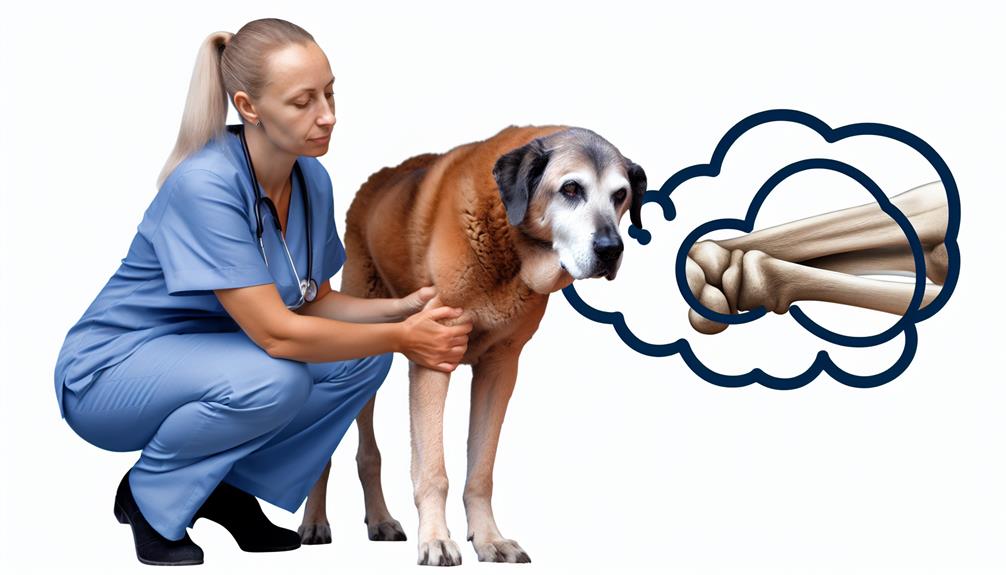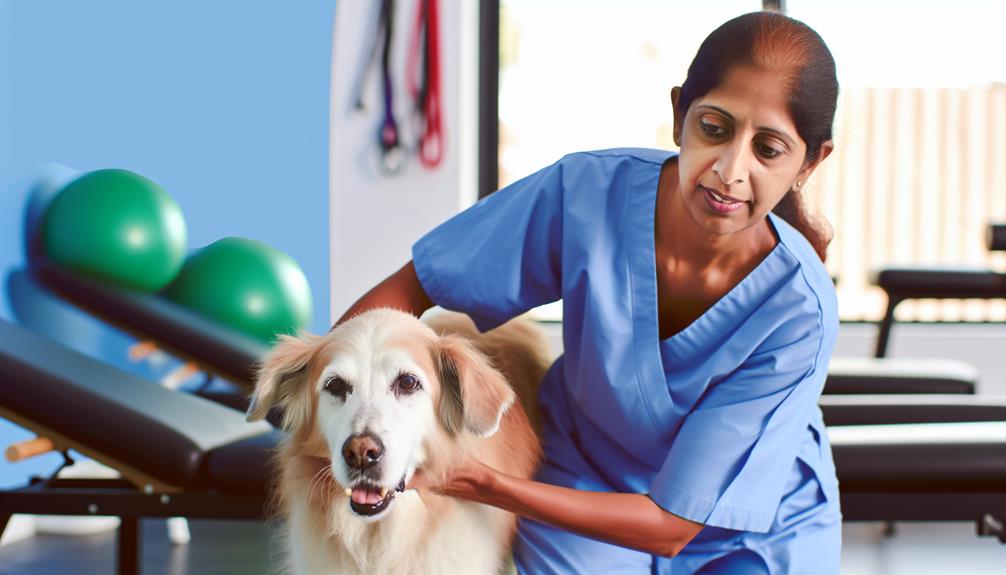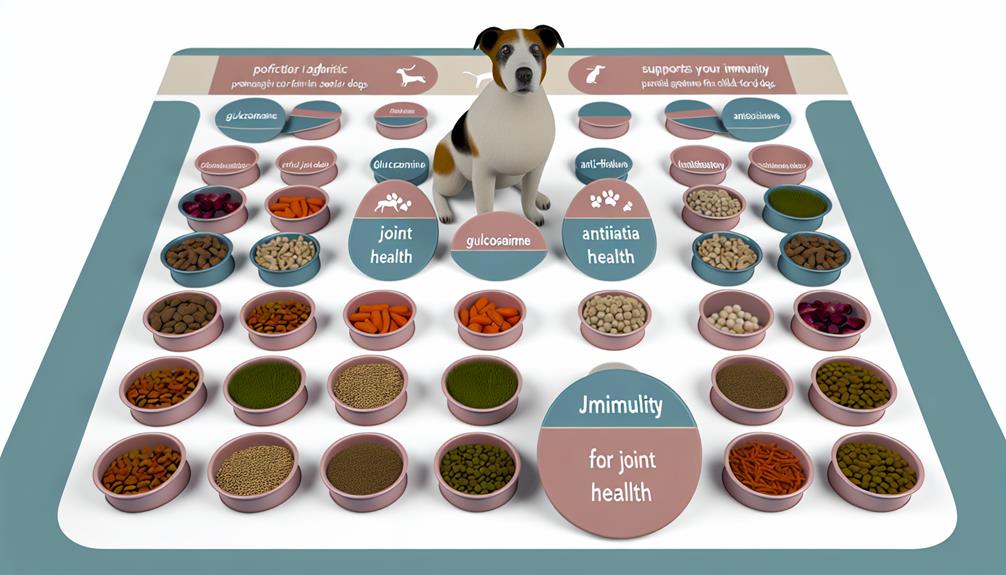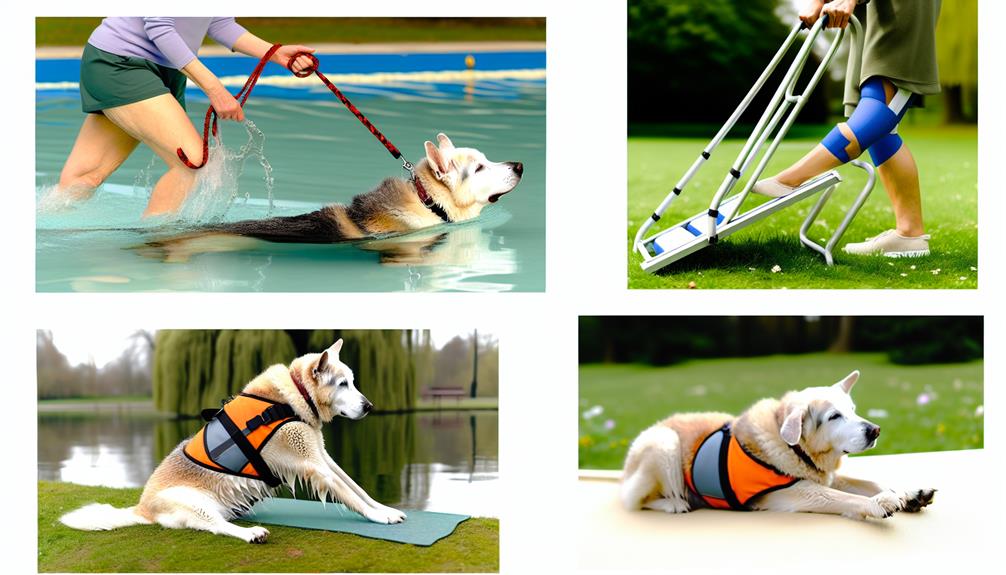As your loyal companion grows older, you may notice subtle changes in their movements and behavior that could be attributed to a common yet often overlooked condition: arthritis. The discomfort and challenges that arthritis brings to older dogs can significantly impact their quality of life. Exploring the signs, management strategies, and treatment options for arthritis in senior canines could offer valuable insights into ensuring your furry friend's well-being and comfort as they age.
Key Takeaways
- Older dogs have increased arthritis risk due to joint wear and tear.
- Reduced mobility in seniors strains joints, causing pain.
- Signs of arthritis in older dogs include limping and difficulty moving.
- Regular vet check-ups and management strategies improve quality of life.
- Joint supplements and weight management are beneficial for senior dogs.
Understanding Arthritis in Dogs

If your older dog is showing signs of stiffness and reluctance to move, it may be a sign of arthritis setting in. Arthritis in dogs is a common condition that causes inflammation in the joints, leading to pain and discomfort. Just like in humans, arthritis can affect dogs' quality of life, making it essential to understand the condition better.
Arthritis can be classified into different types, with osteoarthritis being the most prevalent in older dogs. This type of arthritis occurs when the cartilage within the joint deteriorates over time, causing the bones to rub against each other. This friction leads to pain, swelling, and decreased mobility in your furry companion.
Recognizing the symptoms of arthritis is crucial for early intervention. Besides stiffness and reluctance to move, watch out for signs like limping, difficulty in getting up, or even behavioral changes due to the constant discomfort. Consulting your veterinarian for a proper diagnosis and treatment plan is vital in managing arthritis in older dogs.
Risk Factors for Arthritis
As you explore the risk factors for arthritis in older dogs, consider how age can play a significant role in the development of this condition.
Additionally, take into account the impact that weight can have on the joints of senior dogs, potentially increasing the likelihood of arthritis.
Lastly, genetics can also be a contributing factor, so understanding your dog's breed and family history is crucial in managing and preventing arthritis.
Age and Arthritis
Older age significantly increases the risk of developing arthritis in dogs. As dogs get older, the wear and tear on their joints over the years can lead to the development of arthritis. The cartilage that cushions the joints may start to deteriorate, causing pain and inflammation.
Additionally, older dogs may have reduced mobility and muscle mass, putting more strain on their joints. It's essential to be aware of the signs of arthritis in older dogs, such as limping, difficulty getting up, or reluctance to go up stairs.
Regular vet check-ups and appropriate management strategies, such as weight management and joint supplements, can help improve the quality of life for senior dogs with arthritis.
Weight and Arthritis
Maintaining a healthy weight is a crucial factor in the development and management of arthritis in dogs. Excess weight puts added strain on your dog's joints, leading to increased wear and tear, which can exacerbate arthritis symptoms. Being overweight can also make it harder for your dog to exercise, further contributing to joint stiffness and pain.
Genetics and Arthritis
Genetics play a significant role in determining the risk factors for arthritis in dogs. Certain breeds are more predisposed to developing arthritis due to their genetic makeup. When considering the health of your older dog, it's essential to be aware of these genetic factors that can influence the likelihood of arthritis.
- Breed: Some breeds, such as Labrador Retrievers, German Shepherds, and Golden Retrievers, are genetically more prone to arthritis.
- Family History: Dogs with a family history of arthritis are at a higher risk of developing the condition themselves.
- Genetic Testing: Consult with your veterinarian about genetic testing options to assess your dog's predisposition to arthritis.
Signs and Symptoms
If your older dog is experiencing joint stiffness, a decreased activity level, or difficulty rising up, it might be a sign of arthritis. Keep an eye out for these symptoms as they could indicate that your furry friend is in pain and discomfort.
Early recognition of these signs can help in managing your dog's arthritis effectively.
Joint Stiffness in Dogs
Dogs experiencing joint stiffness often exhibit signs such as reluctance to move or difficulty getting up. You may notice your furry friend showing these symptoms, indicating potential arthritis. Here are some other signs to watch for:
- Limping: Your dog may start favoring one leg over the other while walking.
- Stiffness after Rest: After lying down for a while, your dog may have trouble standing up.
- Difficulty Climbing Stairs: If your dog hesitates or struggles to climb stairs, it could be due to joint stiffness.
If you notice these signs in your dog, it's essential to consult with your veterinarian to explore treatment options and improve your furry companion's quality of life.
Decreased Activity Level
A common indicator of arthritis in older dogs is a noticeable decrease in their activity level. If you notice that your furry companion is less interested in going for walks, playing, or engaging in activities they used to enjoy, it could be a sign of arthritis.
Older dogs with arthritis tend to move less and may even show reluctance to participate in physical activities due to discomfort and pain in their joints. Keep an eye out for any changes in your dog's behavior, such as sleeping more than usual or showing disinterest in their favorite activities.
A decreased activity level in older dogs should prompt a visit to the vet for a proper evaluation and potential management of arthritis symptoms.
Difficulty Rising up
Noticing your older dog struggling to rise up from lying down can be a clear indication of arthritis, particularly in their joints. This difficulty can be distressing for both you and your furry companion. Here are a few signs to look out for:
- Your dog hesitates or takes longer than usual to stand up from a resting position.
- They may vocalize or whine while trying to get up, indicating pain or discomfort.
- Once standing, they might exhibit stiffness or favor one leg over the other when walking.
If you observe these signs, it's essential to consult your veterinarian for a proper diagnosis and discuss potential treatment options to help manage your dog's arthritis.
Diagnosing Arthritis
When observing your aging pet's behavior, you may notice subtle changes that could indicate arthritis. If your dog seems less enthusiastic about activities they once enjoyed, has difficulty getting up, or shows signs of stiffness or limping, it might be time to consider arthritis as a possible cause. Additionally, you may observe your dog licking or chewing at specific joints or being more irritable when touched in certain areas.
To confirm a diagnosis of arthritis, your veterinarian will likely perform a thorough physical examination, which may include assessing your dog's gait, range of motion in the joints, and any signs of discomfort. X-rays are commonly used to visualize changes in the joints, such as narrowing of joint spaces or the presence of bone spurs.
Blood tests may also be recommended to rule out other potential causes of your dog's symptoms. Once a diagnosis is confirmed, your veterinarian can work with you to develop a tailored treatment plan to help manage your dog's arthritis and improve their quality of life.
Treatment Options

Are you wondering how to effectively manage your older dog's arthritis symptoms and improve their comfort and mobility? Here are some treatment options to help alleviate your furry friend's discomfort:
- Weight Management: Keeping your dog at a healthy weight is crucial in managing arthritis. Excess weight puts additional strain on their joints, exacerbating the condition. Consult your vet for a suitable diet plan and exercise regimen to help your dog maintain an optimal weight.
- Physical Therapy: Physical therapy techniques such as gentle massages, stretching exercises, and hydrotherapy can be beneficial for dogs with arthritis. These therapies help improve joint flexibility, reduce pain, and enhance overall mobility. Consider working with a professional animal physical therapist to create a tailored rehabilitation program for your dog.
- Joint Supplements: Supplements like glucosamine and chondroitin can aid in maintaining joint health and reducing inflammation. These supplements can help alleviate arthritis symptoms and slow down the progression of the disease. Discuss with your veterinarian the appropriate dosage and type of supplements best suited for your dog's needs.
Medication for Pain Relief
To alleviate your older dog's arthritis discomfort effectively, exploring medication options for pain relief becomes crucial. When managing your dog's arthritis pain, nonsteroidal anti-inflammatory drugs (NSAIDs) are often prescribed by veterinarians. These medications work by reducing inflammation, relieving pain, and improving your dog's mobility. It's important to follow your vet's dosage instructions carefully to avoid any potential side effects. Additionally, your vet might recommend supplements like glucosamine and chondroitin, which can help support joint health and reduce pain.
In some cases, your vet might suggest opioid medications for severe arthritis pain. These drugs are powerful pain relievers and should only be used under close veterinary supervision due to their potential for side effects and dependence. Another option to consider is corticosteroids, which can provide quick relief from inflammation and pain, but long-term use should be managed cautiously due to potential negative effects on your dog's health.
Always consult with your vet to determine the most suitable medication for your older dog's arthritis pain, taking into account their overall health and specific needs.
Physical Therapy Benefits

Exploring the benefits of physical therapy can significantly improve your older dog's arthritis management. Physical therapy offers a variety of advantages that can help alleviate your furry friend's discomfort and enhance their overall quality of life.
Here are three reasons why physical therapy can be beneficial for your older dog with arthritis:
- Pain Management: Physical therapy techniques such as massage, hydrotherapy, and therapeutic exercises can help reduce pain and inflammation in your dog's joints, promoting better mobility and comfort.
- Improved Range of Motion: Through targeted exercises and stretches, physical therapy can help increase your dog's flexibility and range of motion, making it easier for them to move around and perform daily activities.
- Muscle Strengthening: Physical therapy programs are designed to strengthen your dog's muscles, which can provide better support to their joints, reduce strain, and prevent further deterioration.
Consider incorporating physical therapy into your older dog's arthritis management plan to enhance their well-being and keep them active for longer.
Weight Management Importance
Considering the importance of weight management for your older dog with arthritis can significantly impact their overall health and mobility. Maintaining a healthy weight is crucial in managing arthritis symptoms and reducing discomfort for your furry companion. Excess weight puts added strain on your dog's joints, exacerbating pain and stiffness commonly associated with arthritis. By helping your dog maintain an optimal weight, you can lessen the pressure on their joints, making it easier for them to move around comfortably.
Monitoring your dog's diet and ensuring they receive appropriate portions can aid in weight management. Regular exercise is also essential for keeping your dog at a healthy weight and improving their mobility. Engaging in low-impact activities like short walks or swimming can help strengthen muscles, support joint health, and prevent further weight gain. Consult your veterinarian to determine the best weight management plan tailored to your dog's specific needs and condition.
Dietary Considerations

For improved management of your older dog's arthritis symptoms, paying attention to dietary considerations plays a vital role in their overall health and comfort.
Here are three important dietary considerations to help alleviate your furry friend's arthritis symptoms:
- Omega-3 Fatty Acids: Including foods rich in omega-3 fatty acids, such as salmon, flaxseed, or fish oil supplements, can help reduce inflammation in your dog's joints, easing arthritis discomfort.
- Lean Proteins: Opt for lean protein sources like chicken or turkey to maintain muscle mass and support your dog's overall joint health. Excess weight can exacerbate arthritis symptoms, so it's essential to keep your dog at a healthy weight.
- Antioxidant-Rich Foods: Incorporate fruits and vegetables high in antioxidants, such as blueberries, spinach, and sweet potatoes, into your dog's diet. Antioxidants help combat free radicals that can contribute to joint inflammation and pain, promoting better joint health and mobility for your older dog.
Supplements for Joint Health
To support your older dog's joint health and alleviate arthritis symptoms, incorporating supplements specifically designed for joint support can be beneficial. Glucosamine and chondroitin are popular supplements known to promote joint health by reducing inflammation and supporting cartilage repair. These supplements can help improve your dog's mobility and overall comfort. Omega-3 fatty acids are also beneficial as they have anti-inflammatory properties that can help reduce joint pain and stiffness. Additionally, fish oil supplements can aid in maintaining your dog's joint function.
When choosing supplements for your dog, it's essential to consult with your veterinarian to determine the most suitable options based on your dog's individual needs and health conditions. Your veterinarian can provide guidance on the appropriate dosage and help you select high-quality supplements from reputable brands. It's important to remember that supplements work best when used in conjunction with a balanced diet and regular exercise routine tailored to your dog's specific arthritis condition.
Exercise Modifications

As your older dog battles arthritis, it's crucial to adapt their exercise routine to accommodate their condition. By incorporating gentle movement routines and joint-friendly activities, you can help alleviate discomfort and maintain their mobility.
Making these modifications will ensure your furry companion stays active and healthy despite their arthritis.
Gentle Movement Routines
Consider incorporating gentle movement routines into your older dog's exercise regimen to alleviate arthritis symptoms and improve mobility. Here are some easy routines you can try:
- Short Leash Walks: Take your dog for short walks with a loose leash to reduce strain on their joints.
- Swimming Sessions: Swimming is a low-impact exercise that can help strengthen muscles without stressing the joints.
- Gentle Stretching: Perform gentle stretches to improve flexibility and range of motion in your dog's joints.
These routines can help maintain your older dog's mobility and overall well-being while managing arthritis symptoms.
Joint-Friendly Activities
Incorporate joint-friendly activities that modify your older dog's exercise routine to alleviate arthritis symptoms and enhance their mobility.
Opt for low-impact exercises like swimming or short, leisurely walks instead of high-impact activities.
Encourage gentle movements through activities like stretching or slow-paced games to keep your dog active without causing strain on their joints.
Consider incorporating obstacle courses with ramps and low hurdles to promote movement and cognitive stimulation.
Adjust the duration and intensity of exercise based on your dog's comfort level, gradually increasing difficulty as they build strength.
Monitor your dog for any signs of discomfort during activities and consult with your veterinarian to tailor a suitable exercise plan that supports your older dog's joint health.
Comfort Aids for Dogs
To provide relief for your aging canine companion, consider utilizing various comfort aids designed specifically for dogs with arthritis. These aids can help improve your dog's quality of life and alleviate some of the discomfort associated with arthritis.
Here are three comfort aids that you may find beneficial:
- Orthopedic Dog Bed: Investing in an orthopedic dog bed can provide your furry friend with much-needed support and comfort while they rest. These beds are designed to relieve pressure on your dog's joints and promote better sleep.
- Ramps and Steps: As arthritis progresses, your dog may find it challenging to climb onto furniture or into the car. Using ramps and steps can help your dog access their favorite spots without putting additional strain on their joints.
- Heated Beds or Pads: Heat therapy can be soothing for dogs with arthritis. Consider providing your dog with a heated bed or a heating pad to help ease their joint pain and stiffness, especially during colder months.
Monitoring Arthritis Progression
To effectively monitor your dog's arthritis progression, focus on assessing their pain levels, tracking any changes in mobility, and monitoring joint stiffness. Regularly observing these key points will help you gauge the severity of your dog's arthritis and adjust their treatment plan accordingly.
Pain Level Assessment
Assessing the pain levels in older dogs with arthritis is crucial for monitoring the progression of the condition. To effectively evaluate the pain your furry companion might be experiencing, consider the following steps:
- Observe Their Behavior: Watch for signs such as limping, reluctance to move, or changes in appetite, which could indicate increased discomfort.
- Touch Sensitivity: Gently touch and manipulate their joints to see if they react with pain or discomfort.
- Pain Scale: Use a pain scale provided by your veterinarian to quantify and track the pain levels over time accurately.
Mobility Changes Tracking
Track your older dog's mobility changes regularly to monitor the progression of arthritis effectively. Observe how your dog moves, walks, and plays. Look for any hesitancy, stiffness, or reluctance to engage in physical activities.
Notice if your dog struggles with climbing stairs, getting up from lying down, or jumping onto furniture. Keep a journal or use a mobility tracking app to record any changes you observe.
Measure the distance your dog can comfortably walk and how long they can play without showing signs of fatigue. By consistently tracking these mobility changes, you can provide valuable information to your veterinarian to adjust treatment plans and provide the best care for your arthritic dog.
Joint Stiffness Monitoring
Regularly observing your older dog for signs of joint stiffness is key to monitoring the progression of arthritis effectively.
Here are three ways to help you track joint stiffness in your furry companion:
- Daily Observations: Take note of any difficulty your dog may have when getting up, lying down, or climbing stairs.
- Physical Examination: Gently feel your dog's joints for any swelling, warmth, or pain reactions during petting.
- Movement Assessment: Notice any changes in your dog's gait, such as limping or favoring a particular leg, which could indicate joint discomfort.
Alternative Therapies

Consider exploring holistic approaches to manage arthritis in older dogs, such as acupuncture and massage therapy. These alternative therapies can provide relief and improve your dog's quality of life. Acupuncture involves the insertion of thin needles into specific points on the body to help alleviate pain and inflammation associated with arthritis. It's believed to stimulate the release of endorphins, which are the body's natural painkillers, promoting a sense of well-being in your furry companion.
Massage therapy is another effective alternative treatment for arthritis in older dogs. Gentle massage techniques can help increase circulation, reduce muscle tension, and improve flexibility in the joints. Regular massages can also help your dog relax and may contribute to reducing stress and anxiety levels, which can worsen arthritis symptoms.
When considering alternative therapies for managing arthritis in older dogs, it's essential to consult with a qualified veterinarian or holistic practitioner. They can provide guidance on the most suitable treatment options based on your dog's specific needs and health condition.
Quality of Life Enhancement
Enhancing the quality of life for your older dog with arthritis involves implementing various strategies to promote comfort and well-being. Here are three key ways to enhance your furry friend's quality of life:
- Maintain a Healthy Diet: Ensure your dog is receiving a balanced diet rich in essential nutrients to support joint health and overall well-being. Consider adding supplements like glucosamine and omega-3 fatty acids, which can help reduce inflammation and improve mobility.
- Regular Exercise: While it's important to be mindful of your dog's limitations, gentle exercise routines can help maintain muscle strength, joint flexibility, and a healthy weight. Short, frequent walks or swimming sessions can be beneficial for dogs with arthritis.
- Comfortable Living Environment: Create a cozy and supportive space for your dog by providing a soft, orthopedic bed, easy access to water and food bowls, and gentle grooming to ease any discomfort. Consider ramps or steps to help your dog navigate elevated surfaces with ease.
Frequently Asked Questions
Can Arthritis in Dogs Be Prevented?
You can't fully prevent arthritis in dogs, but you can help reduce the risk by maintaining a healthy weight, providing regular low-impact exercise, a balanced diet, and adding supplements like omega-3 fatty acids.
Are Certain Dog Breeds More Prone to Arthritis?
Certain dog breeds are more prone to arthritis due to genetics and physical characteristics. Regular exercise, a balanced diet, and weight management can help reduce the risk. Consult with your vet for breed-specific advice.
How Can I Help My Arthritic Dog Exercise?
To help your arthritic dog exercise, start with gentle activities like short walks and swimming. Avoid high-impact exercises. Consider ramps or stairs to make movement easier. Consult your vet for tailored exercise plans.
Is Surgery a Common Treatment for Arthritis in Dogs?
Surgery isn't a common treatment for arthritis in dogs. It's usually considered when other options haven't helped. Your vet will guide you on the best course of action based on your dog's specific condition.
Can Arthritis Affect a Dog's Mental Well-Being?
Yes, arthritis can significantly impact a dog's mental well-being. The constant pain and discomfort can lead to irritability, anxiety, and even depression. It's crucial to provide emotional support and comfort to help your furry friend cope.
Conclusion
In conclusion, managing arthritis in older dogs requires a multi-faceted approach to improve their quality of life. By understanding the signs and symptoms, addressing risk factors, and implementing treatment options, pet parents can help their senior dogs live comfortably and happily.
Regular monitoring of arthritis progression and exploring alternative therapies can also enhance the overall well-being of older dogs with arthritis. Remember, your furry friend deserves the best care possible as they age gracefully.







